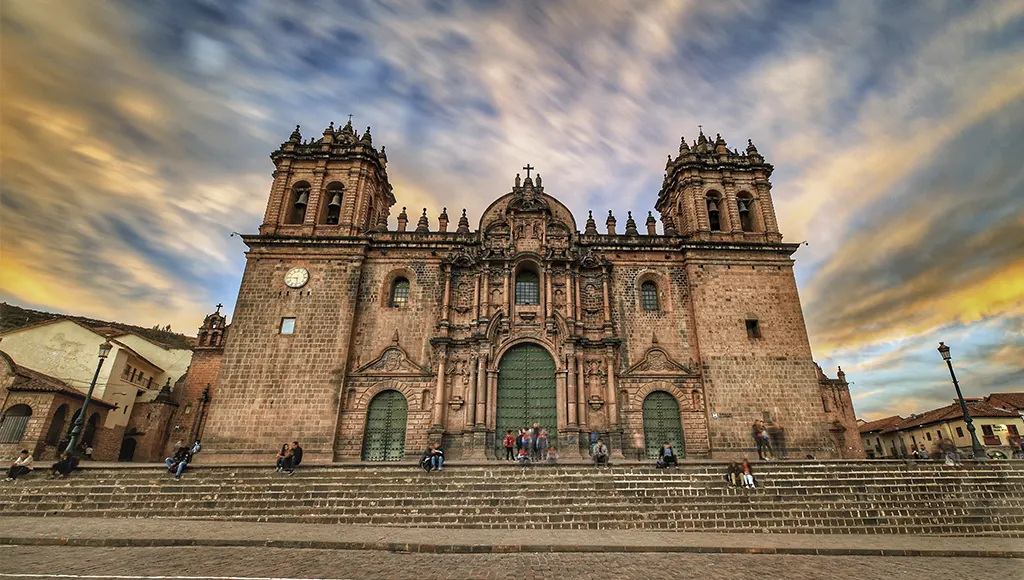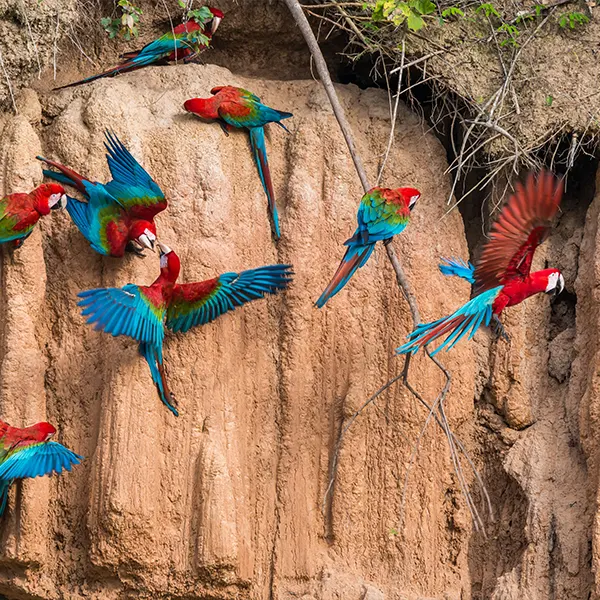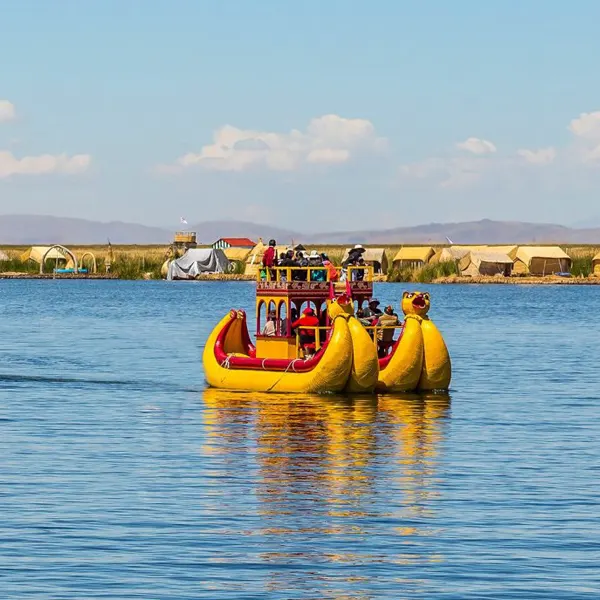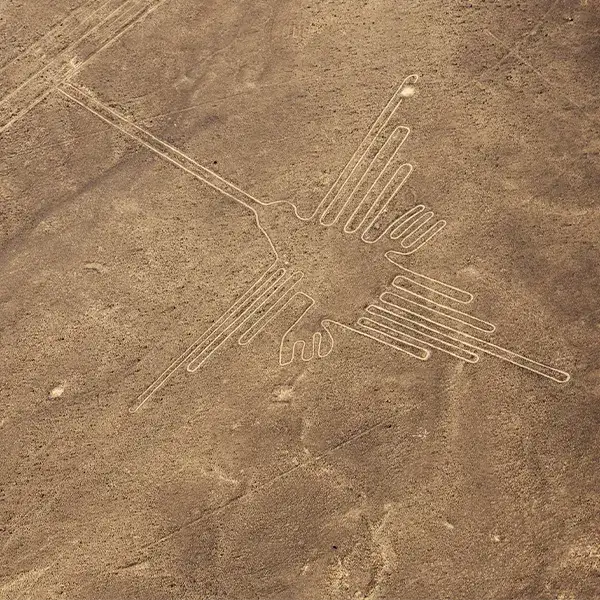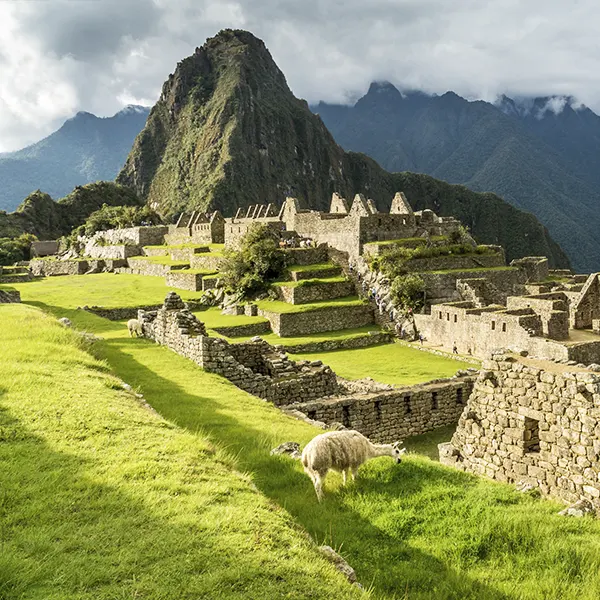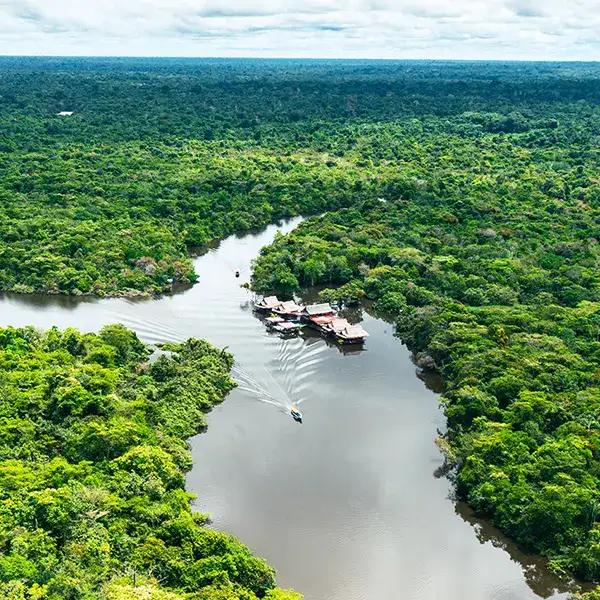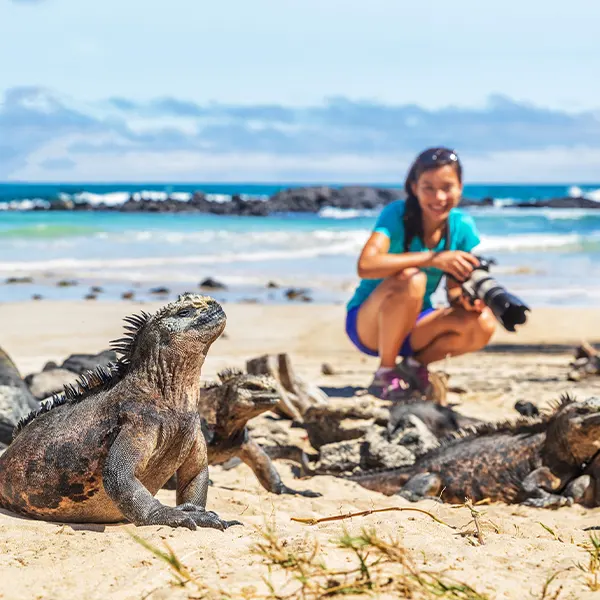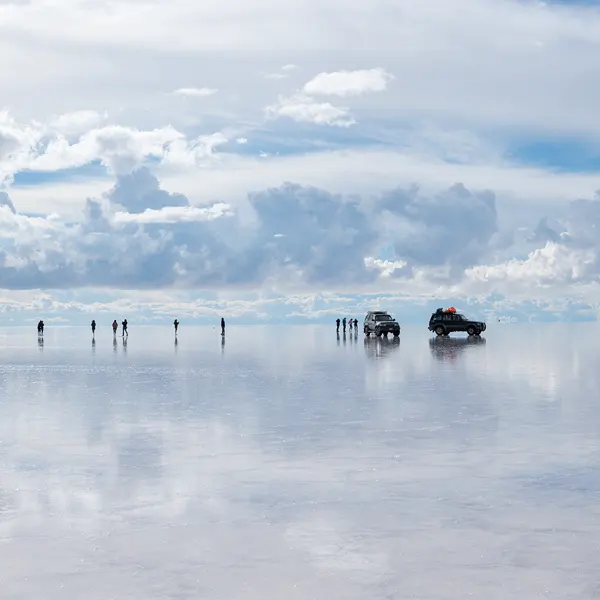The best things to do in Cusco include visiting Machu Picchu, exploring the Sacred Valley, walking through San Blas, touring Inca ruins like Sacsayhuamán, hiking Rainbow Mountain, and experiencing local markets and festivals. From cultural sites to breathtaking landscapes, traveling to the “Rome of the Americas” has something for everyone. That’s why we’ve assembled this guide to help you discover the must-see attractions for your next trip. For many, this destination is one of their favorites on earth; join us to learn why.
The most famous things to do in the Imperial City include:
- Why Cusco is One of South America’s Most Fascinating Destinations
- Top Historical and Cultural Things to Do in Cusco
- Best Archaeological Sites Near Cusco
- Sacred Valley Day Trips from Cusco
- Outdoor Adventures and Nature Experiences
- Food, Markets, and Local Experiences in Cusco
- Other Things to Do in Cusco City Center
- Practical Tips for Visiting Cusco
- FAQs about Things to Do in Cusco
Why Cusco is One of South America’s Most Fascinating Destinations
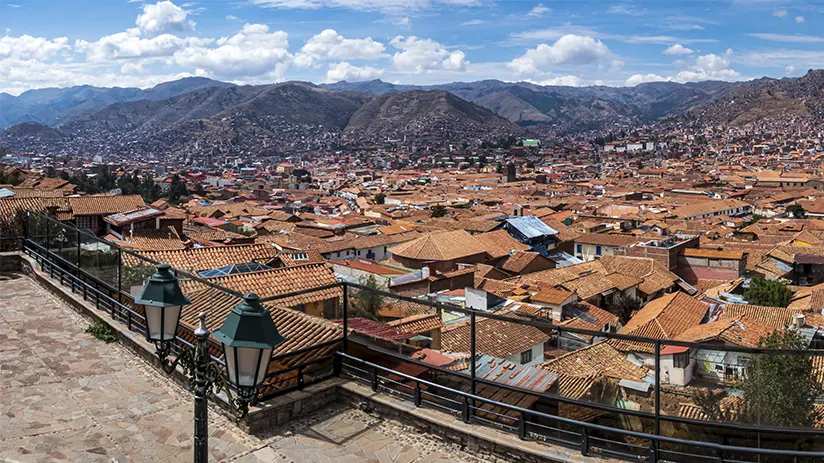
Cusco is one of South America’s most fascinating destinations because of its deep connection with Inca history and culture. From its cobblestone streets to its ancient traditions, every corner of Cusco captivates any traveler. Because of its unique features, UNESCO designated it a World Heritage Site in 1983. Thus, over time, it cemented itself as one of Peru’s most famous and essential treasures in South America.
Top Historical and Cultural Things to Do in Cusco
1. Visit Machu Picchu, Peru’s Most Iconic Inca Site

- Level of demand: Moderate
- Location: 75 km northwest of Cusco / 2438 m.a.s.l. / In the jungle area
- How to get there: By train, or doing the famous Inca Trail trek of 4D/3N
- Entrance ticket: $40 general ticket / $53 ticket + a mountain climb / There are options for underages and students
- Schedule of visit: From 06:00 am to 05:00 pm, all days
- Tips: Always carry your original passports and repellent
The Peruvian Wonder of the World heads the list of top attractions in Cusco and even in South America. Let’s break it down: Machu Picchu is the most important archaeological site around Cusco, often called the lost Inca citadel. For centuries, this sanctuary has been one of the main Inca sites, and today it remains practically intact. Its deep ties to history and natural beauty enchant all who choose to explore it.
As a traveler, you’ll find various ways to visit Machu Picchu, two of which stand out. The first is by hiking the iconic Inca Trail, which follows ancient paths to the historical complex. The second is by taking comfortable trains that offer high-level tourist services and enviable views along the way. Regardless of the route, the experience is undoubtedly memorable and breathtaking.
2. Explore Main Square and the Cusco Cathedral

- Level of demand: Easy
- Location: In the middle of the Cusco historic center
- How to get there: Walking from anywhere in the historic center or taking a taxi from distant locations like the airport
- Entrance ticket: Main Square is a public area / Cusco Cathedral is $11 adult ticket, and $7 underage ticket
- Schedule of entrance: Main Square is a public area / Cusco Cathedral from 10:00 am to 05:00 pm.
- Tips: Take at least a few hours to contemplate every detail and complement it with nearby attractions.
Cusco’s Main Square was one of the main places where some important historical events took place. From the ancient Inca Empire to the present day, this site has a deep connection to the local culture. Nowadays, it is also a major tourist center, featuring various gift shops, establishments, and buildings that reflect the local tradition. Its charming green spaces and cobblestone streets further enrich the experience.
On the other hand, the city’s main church is a prime attraction of the iconic plaza, thanks to its dazzling architecture. The Spanish used the foundations of an ancient Inca temple to build this church, which is now over 350 years old. With a Renaissance-style interior, 14 giant pillars, 24 vaults, and a Baroque facade, it represents a true palace for Catholics. Discovering Cusco Cathedral and its colonial heritage on a day tour will provide you with a glimpse into history.
3. Discover Coricancha and the Santo Domingo Convent

- Level of demand: Easy
- Location: Southeast of Cusco’s Main Square
- How to get there: Walking approximately 3 blocks from the Main Square of Cusco
- Entrance ticket: $6 adult ticket / $3 underage ticket
- Schedule of visit: 08:00 am – 05:00 pm
- Tips: Visiting it with the company of a tour guide is highly recommended.
The sacred Inca temple of Coricancha holds the title of the most significant Andean religious site in the area. Also known as the House of the Sun, it paid tribute to the most prominent Inca god, the Sun. According to research, someone covered its finely carved stone walls in solid gold. Its courtyards and niches featured heavy statues of the same precious metal.
Construction of the Convent of Santo Domingo began after the Spanish arrived and subsequently engaged in looting activities. Builders constructed this colonial church using the foundations of the ancient Inca temple and in the classic Baroque style. Among its main additions are the towers, bell towers, paintings, and Catholic altarpieces. Actually, it is possible to visit it and learn about the history that its architecture holds.
4. Stroll Through the San Blas Artisan Neighborhood

- Level of demand: Easy
- Location: Northeast of Cusco’s Main Square
- How to get there: Walking three blocks from the Cusco Main Square
- Entrance ticket: Public area
- Schedule of visit: Public area
- Tips: Discover the San Blas Viewpoint and take amazing pictures of the ancient Inca capital
The San Blas neighborhood is a popular tourist center and a must-see when exploring Cusco on a walking tour. This region is famous for its numerous local craftsmen who produce distinctive items like textiles, pottery, and artworks. Today, it’s home to a variety of restaurants and bars offering an unparalleled and incredibly diverse culinary experience. For these reasons, this place is one of the best cultural experiences in Cusco that you can find.
Best Archaeological Sites Near Cusco
5. Be Amazed by the Sacsayhuaman Archaeological Complex
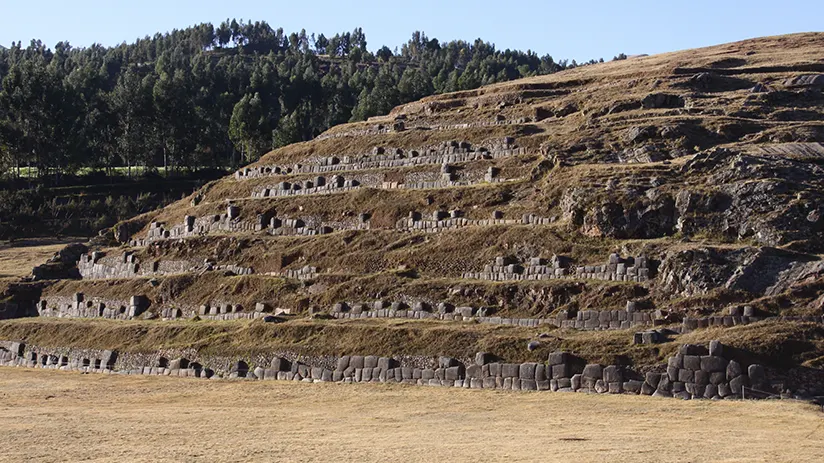
- Level of demand: Moderate
- Location: Two kilometers north of the center of Cusco / 3700 m.a.s.l.
- How to get there: Walking between 30 and 45 minutes from the Cusco Main Square, or taking a taxi
- Entrance ticket: $20 the Cusco Partial Tourist Ticket (City ticket) / $39 the Cusco General Tourist Ticket
- Schedule of entrance: From 07:00 am to 05:00 pm
- Tips: We recommend visiting before noon, with a suitable hat, sunscreen, and windbreaker
Experts in history claim that Sacsayhuamán was vital for the Incas in both religious and defensive aspects. Besides serving as a fortress, lookout post, and barracks, it was a major center for the worship of the god of lightning. What truly captivates visitors even today are its enormous stone blocks, each weighing up to 300 tons. Furthermore, its breathtaking views and exceptional natural surroundings make it a true hidden gem of Cusco.
6. Take a Look at the Ceremonial Site of Qenqo
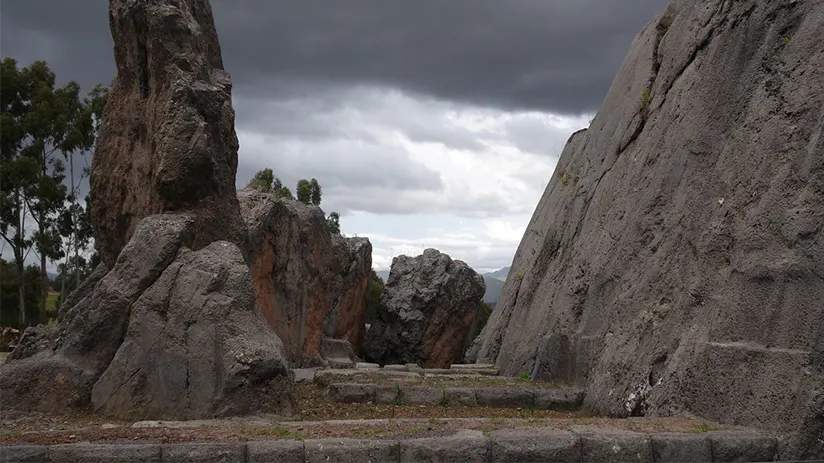
- Level of demand: Moderate.
- Location: Approximately 7 km from the center of Cusco / 3580 m.a.s.l.
- How to get there: By taxi from the Cusco Main Square, the journey takes 20 minutes
- Entrance ticket: $20 the Cusco Partial Tourist Ticket (City ticket) / $39 the Cusco General Tourist Ticket
- Schedule of entrance: From 07:00 am to 05:00 pm
- Tips: Complement your visit with other Cusco tourist places.
The Ceremonial Site of Qenqo was an Inca center of worship to the Sun and Pacha (Earth) gods. Its name means labyrinth in the Quechua language, and it’s because of its large carved stones with small grooves. In addition, ancient people used its large table for ritual offerings to their gods. Now, you can also see other Inca ruins, such as the astronomical observatory and embalming chamber.
7. See the Inca Water Temple of Tambomachay

- Level of demand: Moderate
- Location: Approximately 12 km from the center of Cusco / 3700 m.a.s.l.
- How to get there: By taxi from Cusco, the journey takes 30 minutes
- Entrance ticket: $20 the Cusco Partial Tourist Ticket (City ticket) / $39 the Cusco General Tourist Ticket
- Schedule of entrance: From 07:00 am to 05:00 pm
- Tips: Prepare your camera to take great photos and your personal items for a peaceful experience
Its name means, according to the Inca language, place of rest. The Inca rulers once spent long periods there with their entourage, taking walks and resting. The network of tiny aqueducts culminating in two petite waterfalls amazes every visitor eager to discover it. As one of the quietest Cusco attractions, Tambomachay is ideal for enjoying outdoor adventures near Cusco.
8. Walk the Ancient Ruins of Puka Pukara

- Level of demand: Moderate
- Location: Approximately 10 km from the center of Cusco / 3700 m.a.s.l.
- How to get there: By taxi from Cusco, the journey takes 25 minutes
- Entrance ticket: $20 the Cusco Partial Tourist Ticket (City ticket) / $39 the Cusco General Tourist Ticket
- Schedule of entrance: From 07:00 am to 05:00 pm
- Tips: Try to visit this and the latest archaeological sites on the same tour to maximize your time
Another destination that reflects ancestral history in Cusco is the ancient ruins of Puka Pukara. Like a fortified military stronghold, its most prominent features are its massive walls, terraces, and grand staircases. These structures served as a lookout point against potential threats, such as the ancient Chanka people. A distinctive feature is that, depending on the location, its stones sometimes reflect reddish hues at sunset.
Sacred Valley Day Trips from Cusco
9. Shop at Pisac Market and Visit the Pisac Ruins

- Level of demand: Moderate
- Location: Northeast of Cusco (36 km distance), in the Sacred Valley zone
- How to get there: Taking a collective car or taxi from Cusco, the journey takes approximately 60 minutes
- Entrance ticket: Pisac market is a public area / Pisac ruins is $20 for the Sacred Valley Partial Tourist Ticket or $35 for the Cusco General Tourist Ticket
- Schedule of entrance: From 07:00 am to 05:00 pm
- Tips: As an iconic local market in Cusco, try to look at many establishments before shopping
Pisac was an ancient Inca settlement with Andean terraces, temples, plazas, fortresses, watchtowers, and even a cemetery. All of them are over a hill called Pisac (the name of a native bird that abounds in the place). Nowadays, a little town with a quaint handicraft market sits over its slopes. Both the handicraft market of Pisac and the archaeological park should be must-stops on your Sacred Valley tour.
10. Explore Ollantaytambo Fortress
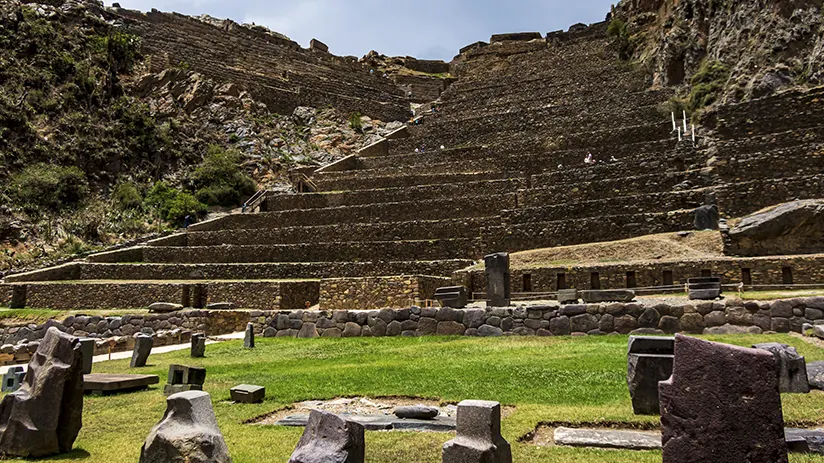
- Level of demand: Moderate
- Location: Northwest of Cusco (61 km distance), in the Sacred Valley zone
- How to get there: Taking a collective car or taxi from Cusco, the journey takes approximately 90 minutes
- Entrance ticket: $20 for the Sacred Valley Partial Tourist Ticket or $35 for the Cusco General Tourist Ticket
- Schedule of entrance: From 07:00 am to 05:00 pm
- Tips: A must-see for those who are going to Machu Picchu, whether by train or Inca Trail.
As the last refuge of the Incas, during their escape from the Spanish invaders, Ollantaytambo highlights. The name of the fortress was in honor of its regent, the famous General Ollanta. Actually, besides being part of millennial history in Cusco, it is one of the most important ruins in the region. Furthermore, its Inca buildings and plazas astonish everyone with their remarkable preservation, making it, for many, a living testament.
11. Visit the Maras Salt Mines and Moray Terraces
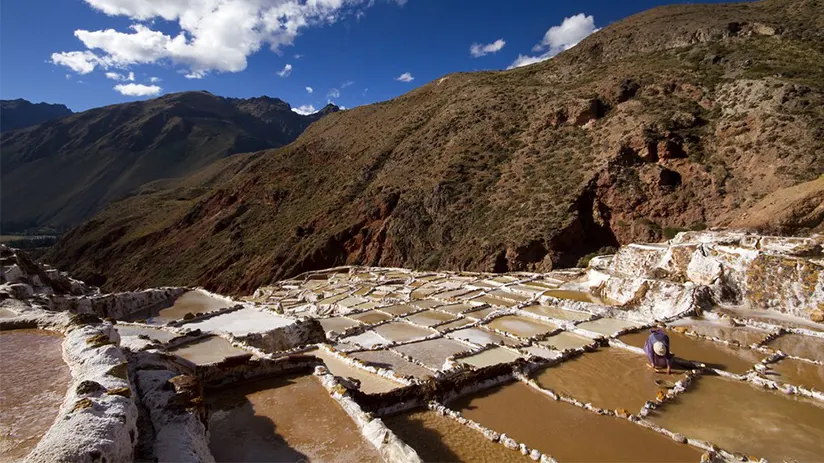
- Level of demand: Moderate
- Location: Northwest of Cusco (50 km distance), in the Sacred Valley zone
- How to get there: Taking a collective car or taxi from Cusco, the journey takes approximately 80 minutes
- Entrance ticket: $20 for the Sacred Valley Partial Tourist Ticket or $35 for the Cusco General Tourist Ticket
- Schedule of entrance: From 07:00 am to 05:00 pm
- Tips: Get your camera ready because both places are picturesque
The salt mines of Maras are more than 3,000 salt wells located over the slopes of Qaqawiñay mountain. According to researchers, these mines have been producing salt since the Inca times. Now, tourists can enjoy its whiteness in a unique experience exploring the Sacred Valley in Cusco. Visitors can buy Maras salt and pink salt, often used for grilling and seasoning meats.
The Incas also obtained a high level of agricultural knowledge to cultivate in the wildlands of the Andes. Moray is evidence of this with its series of circles that enter the earth, a truly spectacular view. Each circle represented a level of altitude, so they can experiment with their crops. As a primary Inca Agricultural Research Center, Moray is an inevitable place to visit near Cusco.
12. Relax in Urubamba, the Heart of the Sacred Valley

- Level of demand: Easy
- Location: Northwest of Cusco (53 km distance), in the Sacred Valley zone
- How to get there: Taking a collective car or taxi from Cusco, the journey takes approximately 80 minutes
- Entrance ticket: Public area
- Schedule of entrance: Public area
- Tips: Carefully evaluate the services you will hire and spend at least one night here, you won’t regret it.
Those seeking a dream getaway amidst exceptional weather and a unique setting should consider Urubamba. As the largest city in the Sacred Valley, this destination offers a contact with local life while also relaxing. Its bars, restaurants, spas, and hotels are just some of the best places that we can mention. Many choose this location to avoid altitude sickness, heading there immediately after arriving at Cusco airport.
Outdoor Adventures and Nature Experiences
13. Hike to Rainbow Mountain (Vinicunca or Palccoyo)

- Level of demand: Challenging
- Location: 139 km southeast of Cusco / 5200 m.a.s.l.
- How to get there: By private vehicle (3 to 4 hours) and a walking leg (1.5 to 2 hours). The main routes are Pitumarca and Cusipata.
- Entrance ticket: $9 for foreign tourists and $5 per national visitor
- Schedule of entrance: From 06:00 am to 04:00 pm
- Tips: Wear a windbreaker, trekking shoes, comfortable pants, and a hat. In the heights, the sun burns, and the gusts of wind are icy
Climate change and global warming caused the snow covering Vinicunca Mountain to melt. This revealed the incredible, naturally colorful slopes of the village of Pitumarca. Rainbow Mountain is a mineralized mountain with diverse hues, ranging from intense oranges to enigmatic greens. However, experts advise caution because the height is considerable and the trek presents challenges.
Its natural beauty has made it popular in recent years; now you can find specialized Rainbow Mountain tours. We recommend planning and creating a pleasant schedule for a relaxed journey. Those who prefer an easier, shorter, and less crowded hike should opt for Palccoyo. Regardless of your choice, you will experience adventure and fascinating landscapes.
14. Trek to the Turquoise Water of Humantay Lake
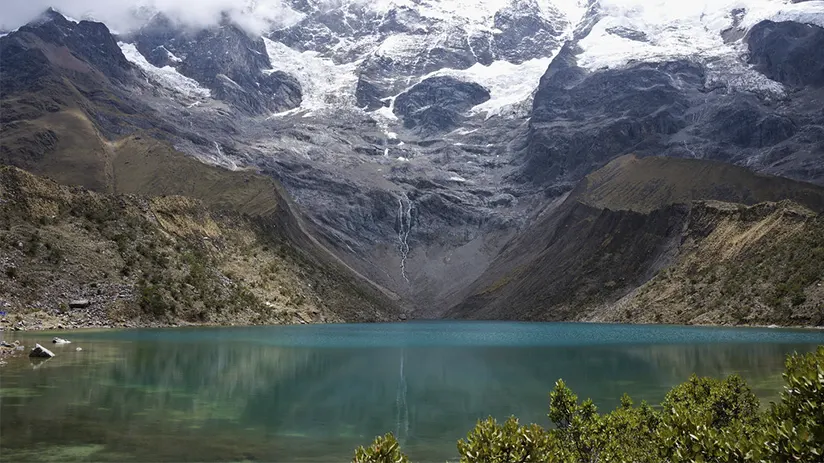
- Level of demand: Challenging
- Location: 124 km northwest of Cusco center / 4,200 m.a.s.l.
- How to get there: By private vehicle (3 to 4 hours) and a walking leg (1.5 to 2 hours)
- Entrance ticket: $6 General Entrance Ticket
- Schedule of entrance: From 06:00 am to 05:00 pm
- Tips: Try to include the first day of the famous 5-day – 4-night trek to the snow-capped Salkantay
The Humantay Lake is another natural jewel that climate change and global warming unveiled to the world. In the ’80s, the lagoon was totally frozen, but over time the ice cap melted until it obtained today’s body of water. Its crystal-clear water reflects the natural beauty of the snow and brings an enviable visual spectacle. Acclimate yourself before doing the Humantay Lake hike to prevent altitude sickness.
15. Experience the Inca Trail to Machu Picchu

- Level of demand: Challenging
- Location: 63 km northwest of Cusco center / Starting near 2,000 m.a.s.l., it reaches its peak at 4,200 m.a.s.l., and descends to 2,430 m.a.s.l.
- How to get there: By private vehicle (2.5 to 3 hours)
- Entrance ticket: Part of a tour package because visitors need a certified guide
- Schedule of entrance: Depends on the type of experience
- Tips: Book several months in advance and carefully choose the certified operator who will accompany you on your journey.
The Inca Trail is an iconic route for adventurers aiming to hike to the gates of Machu Picchu. Beyond its deep connection to ancestral history, its breathtaking combination of ecosystems leaves many visitors speechless. From ancient ruins to lush forests, this trail connects important settlements and centers of ancient civilization. Today, visitors can experience it with a tour provider who will secure the necessary permits and other requirements.
16. Enjoy Scenic Hikes Around Cusco
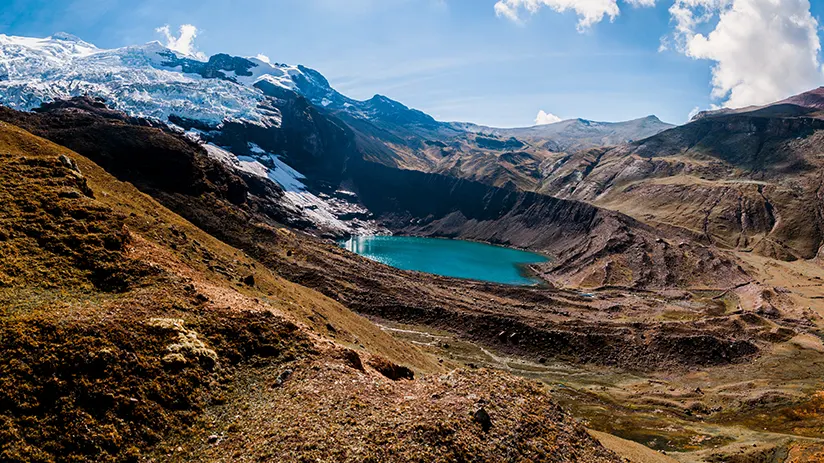
- Level of demand: Challenging
- Location: Depends on the trek (From 2,000 m.a.s.l. to 6,384 m.a.s.l)
- How to get there: It depends on the trek
- Entrance ticket: Part of a tour package
- Schedule of entrance: Depends on the type of experience
- Tips: Evaluate a certified operator because visitors will find many adventurous options.
Incredible panoramic views and pristine landscapes are the highlights of Cusco’s treks. However, vibrant lagoons, snow-capped peaks, and secluded trails are also among its most outstanding features. Fortunately, nowadays you can find a variety of options for outdoor enjoyment and adventure. Among the most popular are the Choquequirao Trek, Salkantay Trek, Lares Trek, and Ausangate Trek.
Food, Markets, and Local Experiences in Cusco
17. Live the Inti Raymi Traditional Festival

- Level of demand: Easy
- Location: Qoricancha / Cusco Main Square / Sacsayhuaman
- How to get there: Qoricancha and Cusco Main Square are in the historic center / Sacsayhuaman is between 30 and 45 minutes from the main square of Cusco
- Entrance ticket: Qoricancha and Cusco Main Square are free / Sacsayhuaman is $100 – $250+
- Schedule of entrance: On June 24th, the ceremony starts in Qoricancha from 08:00 am to 09:30 am. Then it continues in the Cusco Main Square from 10:00 am to 11:00 am. Finally, the main ceremony starts in Sacsayhuaman from 12:00 pm to 03:00 pm.
- Tips: Book your tickets in advance and bring plenty of sun protection.
The quintessential emblem of local traditions and Andean culture in Cusco is Inti Raymi, the Festival of the Sun. With over 300 local dancers and actors, this is a reenactment of the most important Inca festival. Their costumes, music, and rituals immerse everyone in an ancestral atmosphere steeped in tradition. The grand spectacle that unfolds along iconic locations is practically a must-see on any cultural trip.
18. Shop in the San Pedro Market Like a Local
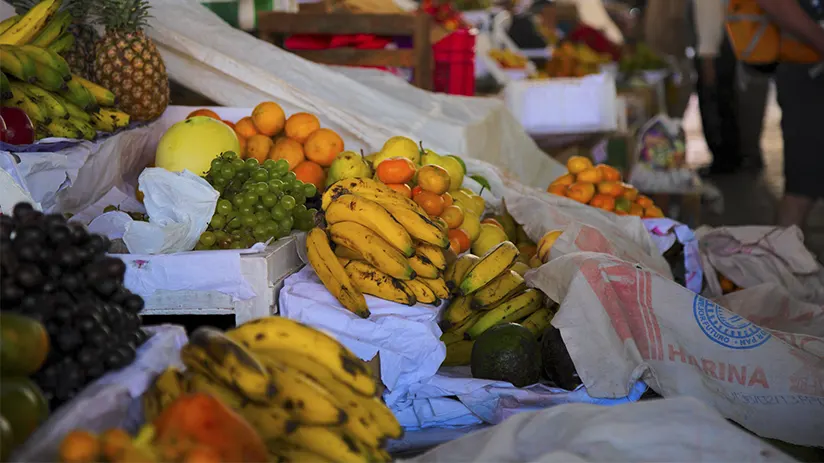
- Level of demand: Easy
- Location: In the historic center of Cusco
- How to get there: Walking 10 minutes to the Cusco Main Square
- Entrance ticket: Public area
- Schedule of entrance: From 06:00 am to 05:00 pm
- Tips: We recommend paying attention to your personal belongings. The market is a popular place, and many people can visit it.
This place is an authentic carnival for the senses, where you will see everything. From tourist souvenirs to regional products, this is one of the most iconic local markets in Cusco. Also, it is a perfect opportunity to meet the tastes of the locals and marvel at everything they offer. Among all the famous places in Peru, this market occupies an important position to live an authentic Andean experience.
19. Participate in the Nightlife of Cusco

- Level of demand: Easy
- Location: The discos, pubs, and bars are in Cusco Main Square and adjoining streets like Procuradores, Tecsecocha, Plateros, Triunfo, and Tigre Streets
- How to get there: Walking through the continuous streets of the Cusco Main Square
- Entrance ticket: Depends on the establishment
- Schedule of entrance: Bars and Pubs usually open from 7:00 pm to 2:00 am the next day. The discos usually work the longest hours, up to 06:00 am
- Tips: Try to go with friends and don’t stray far from the historic center
People who stay in Cusco know that not everything involves guided tours and museums. Visitors can enjoy the vibrant nightlife with its bars and clubs with different themes. Regarding discos, you will find many places to relax with friends and drink or dance for a while.
20. Taste Traditional Andean Cuisine at Local Picanterias

- Level of demand: Easy
- Location: Usually in the main streets of the Cusco historic center
- How to get there: Just walk a few meters from the Cusco Main Square
- Entrance ticket: You just have to consume inside
- Schedule of entrance: Open from 12:00 pm to 4:00 pm
- Tips: Dare to try new dishes and flavors different from those you know, using local products
Picanterias in Cusco are restaurants that represent Peruvian cuisine by serving spicy food. Traditionally, these establishments had long tables and benches where unknown people shared local dishes. Now, Chiriuchu, Cuy al Horno, Capchi de Zetas, or Chairo are some of the most delicious options that you can delight in there. The traditional festivals celebrated in Cusco bring numerous opportunities to experience the Andean culinary experience.
Other Things to Do in Cusco City Center

- Sapantiana aqueduct: The Jesuit order built this aqueduct in 1565 to supply water to the city center. Its four levels of arches formed part of this colonial wall, which incorporates stones brought from the Sapantiana quarry. A gentle trickle of water runs down its stone steps, making it a perfect spot for taking photographs.
- The Cristo Blanco statue: While Rio de Janeiro boasts the iconic Christ the Redeemer, Cusco has its own version. This giant, 8-meter-tall statue, covered in marble and plaster, was a gift from the Arab community to the city in 1945. Visitors can enjoy this striking landmark and its breathtaking panoramic views of the city.
- The viewpoint of San Cristobal: Speaking of magnificent views, we can’t fail to mention the San Cristobal viewpoint. With sweeping vistas of the city, you’ll see many people enjoying its beauty and tranquility. Its small plaza and adjacent Catholic church also greatly enhance the experience.
- The Twelve Angled Stone: The famous twelve-angled stone is an impressive Inca emblem in the historic center. This attraction is breathtaking because of the millimeter-precise carving that allows it to fit perfectly with other stones. As evidence of the advanced engineering of its ancestral people, it stands out as a local must-see.
- The Inca Museum: This museum offers a comprehensive overview of Cusco’s historical periods. From the Stone Age until these days, visitors can find many cultural and historical expressions. Almost a complete Cusco tourist map exists to see before beginning your activities in the ancient Inca capital.
- Traditional workshops: To get closer to experiencing more hands-on kind of tourism, you should consider visiting Cusco’s workshops. Peruvian cuisine, pottery, ceramics, textiles, and chocolate making are currently the most popular choices among tourists. We recommend visiting establishments like the Choco Museo and the craft schools.
Practical Tips for Visiting Cusco
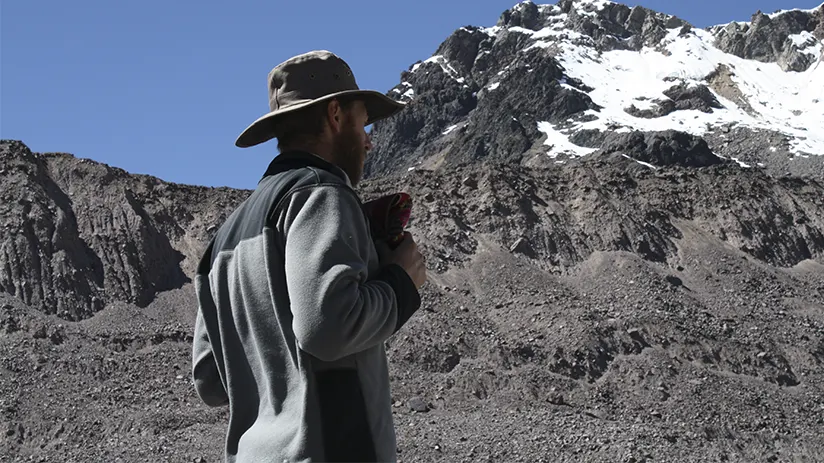
- With so many options to choose from, deciding how to plan and begin your trip can be difficult. We highly recommend hiring a tour operator that allows you to personalize your trip according to your interests. To choose the best option, you should take ample time to evaluate the available alternatives.
- Purchasing travel insurance is essential, whether you plan to travel to Cusco or other nearby destinations. As a traveler, you must consider unforeseen events beyond your control. Therefore, coverage for these unexpected situations is more than necessary.
- One of the main concerns for travelers is altitude sickness. Although it’s not a widespread problem, it’s best to take precautions, many of which include natural remedies. Among the most important are drinking coca tea, staying well-hydrated, and resting during the first hours after arrival. Others are more specific, such as chewing coca leaves directly or taking prescription medication, of course.
- For Cusco, the best packing option is layered clothing. Other items like sunscreen and personal documents are practically indispensable for any activity. To make sure you don’t forget anything, we suggest creating a checklist to get everything ready before your trip.
- Although most establishments in Cusco accept card payments, some still don’t. Therefore, you should familiarize yourself with the local currency and carry some cash. You might have some unexpected expenses, and at the same time, support the local economy.
FAQs about Things to Do in Cusco

What are the best things to do in Cusco in 2 days?
In two days in Cusco, you can explore the historic city center, visit the Main Square, Cusco Cathedral, and Qorikancha. You can also walk through the San Blas neighborhood and enjoy local food. On the second day, a short tour to nearby ruins like Sacsayhuamán, Qenqo, and Tambomachay is a great option.
Is Cusco worth visiting without going to Machu Picchu?
Yes, Cusco is worth visiting even without Machu Picchu. The city has a lot of history, beautiful architecture, colorful markets, and nearby Inca sites. Visitors can enjoy museums, local culture, traditional food, and amazing landscapes around the city.
What are the free things to do in Cusco?
There are many free things to do in Cusco, like walking around the Main Square, visiting San Blas streets, and enjoying viewpoints such as Cristo Blanco. Travelers can also explore local markets like San Pedro Market and see traditional life without spending money.
What is the best time to visit Cusco?
The best time to visit Cusco is from May to September, during the dry season. These months have sunny days and little rain, which is great for walking and tours. June and July are popular, so it can be more crowded.
How many days do you need in Cusco?
Most travelers need at least 3 to 4 days in Cusco. This allows time to adjust to the altitude, explore the city, and visit nearby attractions. If you plan to see the Sacred Valley or take day tours, more days are recommended.
Are Cusco tours safe for travelers?
Yes, Cusco tours are generally safe for travelers, especially in the historic center. Experienced tour operators organize tourism well. Likewise, it is important to choose licensed companies, follow the guides’ instructions, and take basic safety precautions.
What should I not miss in Cusco?
Visitors should not miss the Main Square, Sacsayhuamán, the San Blas neighborhood, and the local markets. Trying Peruvian food and learning about Inca history are also must-do experiences. The mix of culture, history, and scenery makes Cusco special.
“YOU WILL BASE YOUR CHOICE OF WHAT TO DO NOT ONLY ON YOUR INTEREST BUT ALSO ON THE AUTHENTICITY OF THE DESTINATION”
Those who are wondering about why Cusco is one of Peru’s most fascinating historic cities, there is much to discover. As a place full of history, culture, and unforgettable landscapes, every type of traveler can find something special. From walking through its ancient streets to exploring nearby archaeological sites, there are many things to do in Cusco. Come and spend a few days here to connect with local traditions, enjoy great food, and discover the heart of the Inca world.
Cusco has so much to offer; it can be hard to know where to start. With many years of experience in the tourism sector, Machu Travel Peru is happy to help with anything regarding your trip to Cusco and any tours around it. Let us help you make your Cusco travel experience unforgettable! Contact us today to plan your dream adventure!
